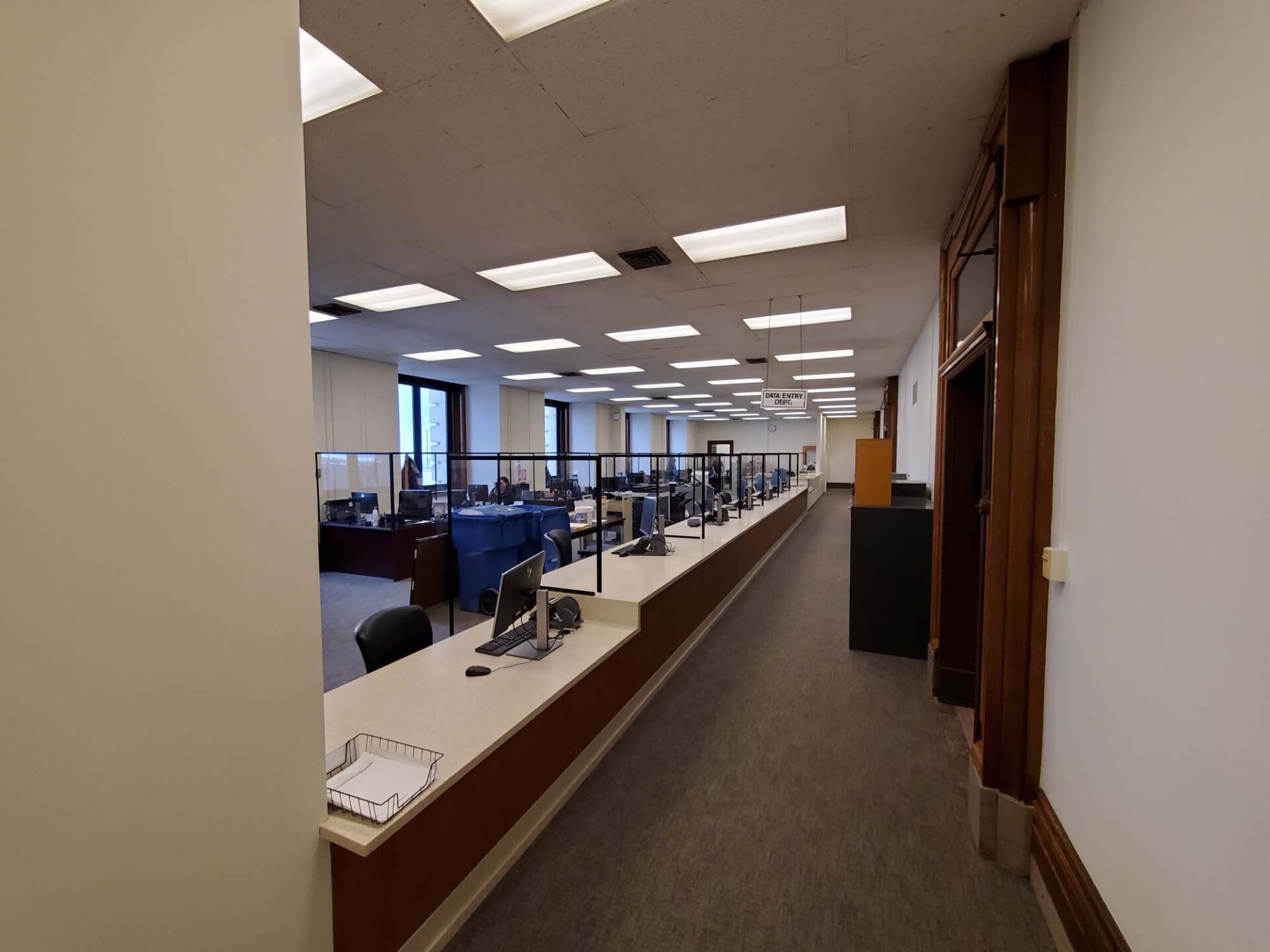
March 12, 2025 | Articles
Get Stoked: Hill International Makes Big Waves in Spain’s Surfing Scene

Since early 2020, local governments around the world have been racing to control the spread of COVID-19 and protect their citizens. Like other municipalities, Cuyahoga County in Ohio strove to keep up with the recommendations of health organizations such as the Centers for Disease Control and Prevention and the World Health Organization. Still, financing widespread and rapid relief programs can be difficult. So when the Federal Government’s Coronavirus Aid, Relief, and Economic Security (CARES) Act provided time-sensitive funds for governments to deploy in their fight against COVID-19, it was imperative for Cuyahoga County to use its allocated $30 million effectively and efficiently.
Since the CARES funds were awarded, Hill has been working with the County to prepare and deliver projects to improve its public buildings and protect citizens against COVID-19. Leveraging Hill’s program and project management expertise, the County was able to package, bid, and complete approximately 65 task orders ranging from $10,000 to $1,100,000 each, with 16 different contractors. The projects, totaling more than $15 million, upgraded more than 30 public buildings, including administration offices, family services centers, jails, courthouses, auto title bureaus, an animal shelter, and the County airport. These upgrades included acrylic and laminate glass partitions, office workstation distancing, wave-to-open doors, arm and foot pulls for doors, touchless restroom faucets, toilets, soap and paper towel dispensers, drinking fountains with touchless bottle fillers, face-temperature scanners, HVAC upgrades including bipolar ionization, UVC radiation, and negative pressurization.
A Two-Pronged Approach
“In many ways, Cuyahoga County’s program is similar to the programs Hill supports all over the world,” says Hill Senior Project Manager Matthew Pawlak, PE. “But the time constraint of the CARES Act funds, the use of small business enterprises (SBE), minority business enterprises (MBE), and female business enterprises (FBE), as well as the urgency of COVID-19 prevention made this program unique. The team had to mobilize immediately and start putting together criteria packages with architectural firms. To expedite the task orders, the County opted to use design-build (DB) delivery. Contractors were competitively selected for a DB master project, then the task orders were awarded to shortlisted contractors or through a mini-bid. This process allowed for the quick selection of contractors and the quick ordering of any COVID-delayed materials. To support the County, we coordinated the master contracts.”
The structure of Hill’s team added to the DB delivery method’s efficiency. Pawlak’s colleague Senior Project Manager Milton Lewis is an expert in planning DB projects and overseeing capital programs, with more than 30 years of experience in contract drafting and negotiation, DB procurement, capital planning, and program management. Because of this, Lewis worked primarily on the preliminary phases of the program, identifying County needs, preparing criteria documents, shortlisting contractors, reviewing mini-bids, writing task-order contracts, approving change orders, and creating the program database. Pawlak, with more than 20 years of experience in construction project management, inspection, documentation, and safety compliance, oversaw the construction operations, approved submittals, answered requests for information, managed the SharePoint site for document control, and lead the Hill inspection team. Essentially, Lewis’ expertise helped get projects off the ground quickly and Pawlak’s helped move them along safely and according to the County’s expectations.
Speed Bumps & Solutions
While the DB delivery method helped the County’s projects reach construction quickly, COVID-19, the speed of the program, and the program’s complexity created several management challenges.
COVID-19 created long lead times for most of the required materials such as partitions, touchless fixtures, furniture, and HVAC equipment. This threatened to push completion dates to or beyond the original CARES Act deadline. In addition, working with individual task order contracts and spreading the work out among the 16 contractors were a couple of the initial challenges. Using his past DB experience, Lewis coordinated with the County and architectural firms to quickly develop criteria packages, pushing them through the County for assignment to the contractors. He created simple, yet effective contract documents with a streamlined process. This helped to mitigate some of the effects of the long-lead items on the projects’ schedules.
In an ideal construction management situation, two or three contractors would have been chosen to support the program for speed, efficiency, and quality control. Selecting 16 contractors creates a large amount of extra managerial work. It also increases the chances of less-qualified contractors being assigned to more technically challenging task orders. Even the very qualified contractors were not always familiar with performing the design required by the DB delivery, especially at the pace required to achieve program schedule goals. Pawlak used his inspection team to supervise the contractors, helping to avoid rework and poor quality.
The work, which involved the installation of high-efficiency fixtures and accessories in century-old buildings, was still a challenge. For example, the team faced several obstacles while installing large, County-specified touchless paper towel dispensers in undersized restrooms with limited electrical access. Hill’s inspectors worked with the contractors to pick the optimal locations for use and power needed, in some instances recessing the fixtures into the wall for a smaller protrusion into the restroom space. Aesthetics and cost control were factored into the decisions. In this way, Hill’s inspection team helped provide the County with the best possible product for the money.
Other challenges had to do with coordination. Given the variety of buildings involved in the program, Hill Lead Inspector Paul Case had to coordinate with a web of different County end users. “Paul had to coordinate with trade representatives from the County, administrators, building end users, and the public,” explains Pawlak. “With so many voices involved, it became time consuming to determine who the decision makers were and get their approvals on construction shift times, building access, contractor badging, and final product needs.”
Similarly, Hill’s team had to use diplomacy to make sure that all voices were heard, and input was duly processed. Pawlak offers an example: “Some end users liked the drawings we showed them, but then they had an issue with the actual results. Milt, Paul, and I had to help everyone understand what we did and why we did it. In some cases, we were able to move the final upgrades closer to what stakeholders wanted.” Ultimately, exceptional communication between the Hill team and other parties involved was one of the keys to program success.
“On normal projects and programs, we’re able to be more involved with the details of each project,” says Pawlak. “But here, we had to spread our attention around evenly as all of these projects were getting started at once. On the whole though, we’ve had very few problems and no major issues. That really comes down to a team effort and it’s pretty impressive considering the large amount of work in such a short amount of time.”
A County Safer & Stronger
In the end, Hill’s team helped ensure all stakeholders were satisfied with their building’s upgrades. More, Lewis, Case and Pawlak helped Cuyahoga County use their CARES Act money efficiently. And now, as the last of the task orders wrap up, more than 30 of the County’s buildings are better prepared to handle COVID-19 and keep Cuyahoga safe. As Pawlak indicated, the team’s success is especially impressive given the amount of work and the time constraints.
Concludes Pawlak: “The whole team knew that this was important work that would protect people. From the County to the architects and all the contractors, everyone deserves a lot of credit for getting all this important work done well. At Hill, we look forward to supporting the County with any of their future program needs.”
Share

March 12, 2025 | Articles
Get Stoked: Hill International Makes Big Waves in Spain’s Surfing Scene

March 9, 2025 | Articles
Project Manager TJ Pinales: Helping Along the Road in San Antonio

March 4, 2025 | Articles
Balancing the Equation: An Interview with Project Manager Tracy Wiyrick

March 1, 2025 | Articles
A Lifelong Project: Calypso Kyriakopoulou’s Multifaceted Career in Construction

February 10, 2025 | Articles
Dual Delivery: A Viable Strategy for Complex Transit Projects

January 23, 2025 | Articles
Plotting a Roadmap to Success on the Torres de Colón Renovation

December 12, 2024 | Articles
Progressive Design-Build for Rail and Transit Projects: Room to Run

December 9, 2024 | Articles
Unlocking Growth: Maximizing the Benefits of the SBA’s Mentor-Protégé Program

December 8, 2024 | Articles
Mediterranean Luxury a Century in the Making: Four Seasons Resort Mallorca at Formentor